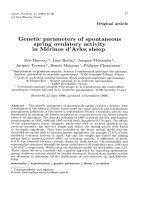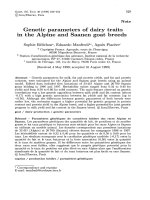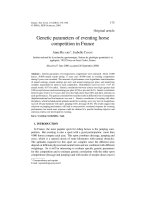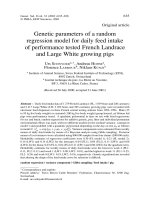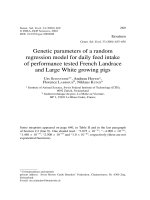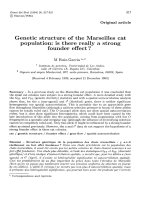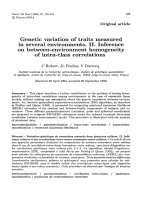Báo cáo sinh học: " Genetic parameters of meat technological quality traits in a grand-parental commercial line of turkey" pot
Bạn đang xem bản rút gọn của tài liệu. Xem và tải ngay bản đầy đủ của tài liệu tại đây (238.95 KB, 13 trang )
Genet. Sel. Evol. 35 (2003) 623–635 623
© INRA, EDP Sciences, 2003
DOI: 10.1051/gse:2003043
Original article
Genetic parameters of meat technological
quality traits in a grand-parental
commercial line of turkey
Élisabeth L
E
B
IHAN
-D
UVAL
a∗
, Cécile B
ERRI
a
, Élisabeth B
AÉZA
a
,
Véronique S
ANTÉ
b
, Thierry A
STRUC
b
, Hervé R
ÉMIGNON
c
,
Gilles L
E
P
OTTIER
d
, James B
ENTLEY
e
, Catherine B
EAUMONT
a
,
Xavier F
ERNANDEZ
b, c
a
Institut national de la recherche agronomique, Station de recherches avicoles,
37380 Nouzilly, France
b
Institut national de la recherche agronomique, Station de recherches sur la viande,
Saint-Genès Champanelle, France
c
École nationale supérieure agronomique de Toulouse,
31326 Castanet-Tolosan, France
d
Comité interprofessionnel de la dinde en France, Mordelles, France
e
British United Turkeys, Chester, UK
(Received 18 June 2002; accepted 7 February 2003)
Abstract – Genetic parameters for meat quality traits and their relationships with body weight
and breast development were estimated for a total of 420 male turkeys using REML. The birds
were slaughtered in a commercial plant and the traits measured included pH at 20 min (pH
20
)
and 24 h post-mortem (pHu) and colour of the breast and thigh meat. The heritabilities of the rate
and the extent of the pH fall in the breast muscle were estimated at h
2
= 0.21 ± 0.04 and h
2
=
0.16 ± 0.04, respectively. Heritabilities ranging from 0.10 to 0.32 were obtained for the colour
indicators in the breast muscle. A marked negative genetic correlation (r
g
= −0.80 ± 0.10)
was found between pH
20
and lightness (L
∗
) of breast meat, both traits corresponding to PSE
indicators. The pH
20
in the thigh muscle had a moderate heritability (h
2
= 0.20 ± 0.07) and
was partially genetically related to pH
20
in the breast muscle (r
g
= 0.45 ± 0.17). Body weight
and breast yield were positively correlated with both initial and ultimate pH and negatively with
the lightness of breast meat.
turkey / meat quality / pH / colour / genetic parameters
∗
Corresponding author:
624 É. Le Bihan-Duval et al.
1. INTRODUCTION
Poultry meat production has been very dynamic over the last decade during
which time it has been greatly diversified with a large increase in the volume
of the joints and processed products. This success has been strongly related
to the improvement in growth and carcass yield, with a significant increase
in the breast muscle proportion. More recently, due to consumer preferences
and the industry demands, improvement of the meat quality has become a
more prevalent concern. As in pigs, the fall of post-mortem pH significantly
affects the storage and processing quality of poultry meat. In particular, a low
pH in the early stages of rigor onset when muscle temperature is still high
leads to protein denaturation, responsible for a poor water-holding capacity,
bad functional properties and a pale colour of the meat [7,14,21]. Although
the underlying mechanisms have not yet been elucidated in poultry, these meat
defects described in turkeys and chickens have been identified by analogy
with pigs as the PSE (pale soft exudative) like syndrome [26]. Ultimate pH
also modifies the technological properties of the meat, with a low pH being
associated with a decreased water-holding capacity and a pale colour [2,3],
and a high pH with a poor storage quality [1]. Meat quality is influenced by
a large number of factors, including environmental conditions such as stress
before slaughter but also genetics. The genetics of the meat quality has been
widely studied in pigs leading to the application of selection methodology to
improve meat quality. In this species, a significant polygenic determinism of
several meat traits has been shown as well as a strong impact of a few major
genes [24]: most notably, the halothane sensitivity gene [20] responsible for the
PSE phenotype and the RN gene [18] responsible for the “acid meat” condition
have been well defined. By contrast with pigs, the genetic determinism of meat
quality in poultry is poorly defined. Interestingly, significant levels of heritab-
ility were obtained for several meat quality traits in chickens in a recent study
reporting first estimates of genetic parameters [17]. However, this experiment
was realised under highly controlled experimental conditions, which did elicit
the expression of meat quality defects. Thus, the present study was aimed
at estimating the genetic parameters of muscle post-mortem pH fall and of
meat colour measured under commercial conditions. This genetic analysis was
conducted in turkeys for which meat quality is an important issue because a
large part of turkey production is consumed as further-processed products.
2. MATERIALS AND METHODS
2.1. Animals
A total of four hundred and twenty turkey toms, originating from a com-
mercial grand-parental dam line (BUT Ltd., Chester, UK) were used for this
Genetics of meat quality in the turkey 625
Table I. Composition of the diets distributed during the rearing period.
Composition (%) 0–4 weeks 4–8 weeks 8–16 weeks
Maize 0 25.82 18.86
Wheat 45 14.46 31.9
Rapeseed oil 5 5 6
Soyabean meal 36.9 26.6 15.56
Corn gluten meal 5.7 6 6
Spring peas 0 0 15
Calcium carbonate 1.03 0.98 1.01
Dicalcium phosphate 3.73 3.69 3.42
Sodium chloride 0.4 0.4 0.4
Trace minerals 0.1 0.1 0.1
Vitamins 0.5 0.5 0.5
DL-methionine 0.4 0.43 0.44
L-lysine 0.86 0.7 0.75
Anticoccidial 0.05 0.05 0.05
Tryptophan 0.04 0.05 0.1
Threonine 0.34 0.27 0
Characteristics (calculated)
Metabolisable energy (MJ · kg
−1
) 12.06 12.60 13.22
Crude proteins (g · kg
−1
) 260 240 200
Lysine (g · kg
−1
) 19.20 17.10 14.70
Methionine + cystine (g · kg
−1
) 12.50 12.00 11.10
Calcium (g · kg
−1
) 13.90 13.30 12.60
Available phosphorus (g · kg
−1
) 7.80 7.40 7.10
genetic analysis. This line was in generation eight, after closing from a cross
of two similar phenotypically female lines. It was normally maintained with
60 males and 480 females. The offspring used for the present study were the
progeny of 30 sires and 118 dams. All these birds were reared under similar
conditions in a conventional poultry house at the Inra Avian Research Centre
of Nouzilly, France. Feed and water were provided ad libitum throughout the
growth period, until sixteen weeks of age. Three successive different diets
were distributed at different ages (Tab. I). The birds were individually weighed
at the day before slaughter. After a transport of about 2 h, the birds were
slaughtered in a commercial plant (LDC, Sablé-sur-Sarthe, France) following
usual commercial practices.
626 É. Le Bihan-Duval et al.
2.2. Muscle sampling and meat trait measurements
The pH of the meat was recorded in both the breast in the Pectoralis
superficialis (PS) muscle and the thigh in the Ilio tibialis (IT) muscle, at
20 min (pH
20
) and 24 h post-mortem. The first time of measurement estimated
the rate of the pH fall and the second one the ultimate pH (pHu) of the meat.
At 20 min post-mortem, 2 g of fresh muscle were immediately homogenised in
18 mL of 5 mM iodoacetate buffer and the pH of the homogenate was measured
using a portable pH-meter combined with a glass electrode. This method was
described as the reference method by Santé and Fernandez [22]. At 24 h
post-mortem, pH was assessed by a more rapid method by inserting the probe
in the muscle. This was permitted by the strong correlation obtained at 24 h
post-mortem between the direct tissue measurement of pH and the reference
method [22].
The colour of the meat was recorded at 24 h post-mortem on the PS and IT
muscles using CR 300 Minolta colorimeters. The CIE L
∗
a
∗
b
∗
system was used,
where L
∗
is the lightness of the meat, a
∗
the redness and b
∗
the yellowness.
The chroma (C) and Hue (H) values were also calculated as C =
(a
∗2
+ b
∗2
)
and H = tan
−1
(b
∗
/a
∗
). Chroma is a measure of the colour intensity which
increases when a
∗
and/or b
∗
increases. Hue indicates the degree of change of
the colour from red (low values of H) to yellow (high values of H).
The weight of the two breast muscles was also recorded at 24 h post-mortem.
Breast yield was estimated as the weight of the breast muscles divided by body
weight before slaughter.
Basic statistics for the different traits were calculated using the UNIVARI-
ATE procedure of SAS
®
[23]. Mean characteristics of the PS and IT muscles
were compared by a t-test.
2.3. Estimation of the genetic parameters
Coefficients of heritability (h
2
) for the various meat traits as well as genetic
correlation coefficients r
g
and phenotypic correlation coefficients r
p
were estim-
ated. Genetic parameters were obtained by the REML (restricted maximum
likelihood) methodology with VCE (version 4.2.5) software [12]. The model
of analysis included the genetic effect of each animal, and for the colour meas-
urements, the fixed effect of the colorimeter. Although the three colorimeters
used for this experiment provided different mean colour values, the standard
deviation for each measurement did not largely vary between instruments (L
∗
:
49.3 ± 2.1, 51.9 ± 2.6, 48.2 ± 2.7; a
∗
: 3.6 ± 1.3, 2.4 ± 1.2, 3.5 ± 1.5; b
∗
:
4.1±1.3, 7.10±1.5, 4.4±1.5 for the colour measurements in PS by colorimeter
1, 2 and 3, respectively). The fixed effect of the operator was thus introduced
in the model to take into account this instrumental variation.
Genetics of meat quality in the turkey 627
In order to increase the accuracy of the genetic parameter estimation, pedi-
gree information to ancestors of the parents of the animals used for the study
was also considered. This comprised a total of 44 sires and 67 dams for the
generation hatched in 1999 and 48 dams for the generation hatched in 1998.
An initial global estimation of the genetic parameters of body weight, breast
yield and the various breast meat characteristics was carried out. This failed
to achieve convergence probably because of the high estimated genetic correl-
ations between the C and H parameters and the a
∗
and b
∗
parameters. Two
distinct analyses were therefore performed, the first analysis included body
weight, breast yield, plus pH
20
, pHu, L
∗
, a
∗
, b
∗
measured in the breast, while
the second analysis included the same traits except that a
∗
and b
∗
were replaced
by C and H. The estimated genetic parameters with their standard errors for
body weight, breast yield, pH
20
, pHu, L
∗
, a
∗
, b
∗
in the breast were obtained by
the first analysis. In a second step, the estimated heritabilities for the C and
H parameters in the breast and their genetic correlations with the other traits
as well as the corresponding standard errors were obtained from the second
analysis. Genetic correlations between a
∗
, b
∗
, C and H indicators in the breast
were estimated by a specific multi-trait analysis of these four traits. The
latter failed to achieve convergence and later did not provide standard errors
of the estimates. As for the breast meat characteristics, the global analysis
for the thigh meat characteristics failed to achieve convergence, so that two
distinct analyses were carried out, the first one including pH
20
, pHu, L
∗
, a
∗
, b
∗
parameters and the second one C and H parameters. Finally, a specific analysis
of pH
20
in both breast and thigh meat was performed to estimate the genetic
correlation between the rates of pH fall for both muscles.
3. RESULTS
The basic statistics for meat traits as well as body weight (BW) and breast
yield (BRY) are reported in Table II. A wide variation in pH and colour was
observed in both PS and IT muscles. The rate and the extent of the pH fall were
lower in IT than in PS (P < 0.001). Lightness was higher in PS than in IT (P <
0.001), whereas the Hue value indicated that breast meat was more yellow and
less red than thigh meat (P < 0.001). The estimated phenotypic correlations
between the breast and thigh characteristics are presented in Table III. High
positive correlations were observed between the two muscles for both the initial
and the final pH of the meat (0.49 and 0.52, respectively), as well as the b
∗
and
H colour indicators (0.57 and 0.60, respectively).
The genetic parameters as well as the phenotypic correlations for breast meat
characteristics, BW and BRY are presented in Table IV. The REML procedure
assumed the normal distribution of the traits, this condition being not fully
satisfied for some of the meat traits (especially a
∗
in PS and pHu in PS and IT).
628 É. Le Bihan-Duval et al.
Table II. Basic statistics for meat traits, body weight and breast yield in the data set
used for the genetic analysis.
Trait n Mean ± SD Range Skewness Kurtosis
Body weight (g) 420 11 648 ± 914 8090–14 150 −0.78 1.95
Breast yield (%) 420 15.9 ± 1.3 11.7–19.7 −0.54 0.60
Pectoralis superficialis muscle
pH
20
398 6.25 ± 0.22 5.72–6.90 −0.19 −0.61
pHu 414 5.90 ± 0.11 5.50–6.24 −0.51 0.83
Lightness (L
∗
) 417 49.7 ± 2.9 40.3–58.4 0.14 0.42
Redness (a
∗
) 418 3.2 ± 1.4 0–9.9 1.03 1.87
Yellowness (b
∗
) 416 5.1 ± 1.83 0.2–10.9 0.39 −0.32
Chroma (C) 416 6.20 ± 1.79 1.02–13.8 0.47 0.34
Hue (H) 415 0.99 ± 0.24 0.37–1.57 0.02 −0.52
Ilio tibialis muscle
pH
20
389 6.42 ± 0.12 6.05–6.77 −0.16 0.02
pHu 415 6.05 ± 0.13 5.56–6.48 −0.62 1.01
Lightness (L
∗
) 419 48.6 ± 2.6 39.9–58.7 0.18 0.83
Redness (a
∗
) 420 9.2 ± 1.4 4.7–13.4 0.00 0.49
Yellowness (b
∗
) 420 2.7 ± 1.88 −1.4–8.4 0.57 −0.36
Chroma (C) 420 9.77 ± 1.55 4.71–14.98 −0.03 0.48
Hue (H) 420 0.28 ± 0.18 −0.18–0.85 0.46 −0.36
pH
20
: pH at 20 min post-mortem; pHu: ultimate pH at 24 h post-mortem.
Table III. Phenotypic correlations (r
p
) between the Pectoralis superficialis (PS) and
Ilio tibialis (IL) characteristics.
pH
20PS
pHu
PS
L
∗
PS
a∗
PS
b∗
PS
C
PS
H
PS
pH
20IL
0.49
1
0.17
2
−0.10
3
−0.10 0.05 0.00 0.12
3
pHu
IL
0.05 0.52
1
0.01 −0.06 −0.02 −0.05 0.02
L
∗
IL
0.00 0.05 0.27
1
−0.17
2
0.23
1
0.14
3
0.28
1
a
∗
IL
0.00 −0.04 0.03 0.00 0.02 0.02 −0.02
b
∗
IL
0.00 0.01 0.39
1
−0.35
1
0.57
1
0.36
1
0.61
1
C
IL
−0.01 −0.04 0.19
1
−0.13
3
0.25
1
0.17
2
0.22
1
H
IL
0.01 0.02 0.40
1
−0.35
1
0.57
1
0.36
1
0.60
1
pH
20
: pH at 20 min post-mortem; pHu: ultimate pH at 24 h post-mortem; L
∗
:
lightness; a
∗
: redness; b
∗
: yellowness; C: chroma; H: Hue.
1
P < 0.0001;
2
P < 0.001;
3
P < 0.05. r
p
values without exponents are non significant.
Genetics of meat quality in the turkey 629
Table IV. Heritabilities (h
2
, on the diagonal in bold) and genetic correlations (r
g
, above the diagonal) with their approximate standard
errors as well as phenotypic correlations (r
p
, below the diagonal) for meat traits measured in the Pectoralis superficialis muscle, body
weight (BW) and breast yield (BRY).
BW BRY pH
20
pHu L
∗
a
∗
b
∗
C H
BW 0.35 ± 0.05 0.11 ± 0.10 0.55 ± 0.10 0.55 ± 0.11 −0.41 ± 0.19 0.13 ± 0.11 −0.49 ± 0.15 −0.39 ± 0.17 −0.29 ± 0.13
BRY 0.25
1
0.32 ± 0.04 0.62 ± 0.10 0.23 ± 0.14 −0.24 ± 0.17 −0.18 ± 0.12 −0.31 ± 0.13 −0.46 ± 0.16 −0.02 ± 0.11
pH
20
0.21
1
0.07 0.21 ± 0.04 0.59 ± 0.10 −0.80 ± 0.10 −0.25 ± 0.11 −0.35 ± 0.20 −0.62 ± 0.18 0.04 ± 0.11
pHu 0.15
3
0.06 0.26
1
0.16 ± 0.04 −0.53 ± 0.19 0.08 ± 0.12 −0.15 ± 0.21 −0.14 ± 0.21 −0.10 ± 0.16
L
∗
0.06 0.17
2
−0.19
1
−0.17
2
0.12 ± 0.04 0.22 ± 0.13 0.54 ± 0.18 0.69 ± 0.17 0.11 ± 0.16
a
∗
−0.11
3
−0.13
3
−0.22
1
−0.08 −0.11
3
0.21 ± 0.05 −0.09 ± 0.20 0.59 (ne) −0.86 (ne)
b
∗
0.12
3
0.11
3
0.01 −0.06 0.57
1
0.01 0.14 ± 0.04 0.70 (ne) 0.61 (ne)
C 0.05 0.03 −0.09 −0.09 0.47
1
0.44
1
0.89
1
0.10 ± 0.04 −0.13 ± 0.19
H 0.18
2
0.17
2
0.19
1
0.00 0.48
1
−0.70
1
0.67
1
0.27
1
0.32 ± 0.07
pH
20
: pH at 20 min post-mortem; pHu: ultimate pH at 24 h post-mortem; L
∗
: lightness; a
∗
: redness; b
∗
: yellowness; C: chroma;
H: Hue. ne: non estimable.
1
P < 0.0001;
2
P < 0.001;
3
P < 0.05. r
p
values without exponents are non significant.
630 É. Le Bihan-Duval et al.
However, since the deviations from normality were not so drastic and since
REML is rather robust to non normality, it was preferred not to perform box-
cox transformation for data whose biological interpretation is not obvious. The
heritabilities for pH
20
and pHu in PS muscle were estimated as 0.21 ± 0.04 and
0.16 ± 0.04, respectively. Colour indicator heritabilities ranged from 0.12 to
0.32. The rate and the extent of the pH fall were significantly positively related,
with a phenotypic correlation of 0.26 and a genetic correlation of 0.59 ± 0.10.
The lightness of the breast meat was closely genetically related to the rate of
the pH fall (−0.80 ± 0.10) and, to a lesser extent, to the ultimate pH (−0.53 ±
0.19). Phenotypic correlations were more moderate but still significant (−0.19
and −0.17 with pH
20
and pHu, respectively). The redness and yellowness of
the breast meat also appeared significantly genetically related to pH
20
, with
negative correlations of −0.25 ± 0.11 and −0.35 ± 0.20, respectively. This
resulted in a significant negative genetic correlation between pH
20
and the
C value of breast meat (−0.62 ± 0.18). By contrast, no significant genetic
relationship was observed between the Hue value and the post-mortem pH
fall in breast muscle. A significant positive genetic correlation between the
lightness and the yellowness of breast meat was observed (0.54 ± 0.18).
This is consistent both traits being related to the rate and the extent of the
pH fall in a similar direction. Both BW and BRY showed positive genetic
correlations, ranging from 0.23 to 0.62, with both initial and ultimate pH
in breast muscle. The corresponding phenotypic correlations were low to
moderate but still positive (from 0.06 to 0.21). The measures of BW and BRY
were negatively genetically correlated to the L
∗
, a
∗
, b
∗
and C values.
An estimated heritability of 0.20 ± 0.07 was found for pH
20
in the thigh
muscle. In addition, a significant positive genetic correlation was obtained
between the value of pH
20
in PS and IT muscles (0.45 ± 0.17). The remaining
quality characteristics measured in the thigh had lower heritabilities when
compared to the breast: 0.02 for pHu, 0.04 for L
∗
, 0.002 for a
∗
, 0.14 for b
∗
,
0.025 for C and 0.11 for H. Therefore, the genetic correlations between the
thigh meat characteristics (data not shown) will not be discussed.
4. DISCUSSION
A wide range of rate of pH fall was observed in the present study conducted
under commercial slaughtering conditions. A significant proportion of the birds
exhibited fast rates of pH fall. Further investigations confirmed that the breast
meat produced by birds showing the fastest pH decline (16% of the population
with pH
20
below 6) was characterised by a significantly reduced processing
yield and higher drip loss of commercially packed products [10]. This great
variability in the pH
20
values contrasted with the results of a previous study
on birds of the same genetic type slaughtered under experimental conditions,
Genetics of meat quality in the turkey 631
in which the pH
20
in breast meat remained above 6 [9]. These results confirmed
that stressful commercial conditions favour the incidence of PSE defects in
poultry. They also showed that the environment chosen to record meat traits
may strongly affect the results of the genetic analyses.
This study shows for the first time in poultry that the rate of post-mortem pH
fall measured in commercial conditions is partly genetically determined. The
estimated heritabilities for pH
20
in PS and IT were similar to the mean value
of 0.16 reported by Sellier [24] in pigs obtained by averaging the heritabilities
of a large number of studies. Few studies have reported the heritability of the
rate of pH fall in poultry. Indeed, only one estimate has been published by
Le Bihan-Duval et al. [17] in chickens, using animals reared and killed under
experimental conditions. The heritability of pH measured at 15 min post-
mortem in the breast meat was then estimated at a high value (0.49), which
could suggest different genetic determinisms according to the poultry species.
It could also suggest a significant impact of the slaughter conditions on the rate
of pH fall.
A significant positive genetic correlation was observed between the rate
and the extent of the post-mortem pH fall in breast meat. This was a rather
surprising result since it is usually assumed that these parameters are controlled
by different mechanisms: the ultimate pH is mainly determined by the initial
glycogen reserve of the muscle at the time of slaughter, while the rate of pH
fall is determined by the rate of ATP hydrolysis at death in relation with muscle
metabolism and stress response of the bird [26]. In pigs, the existence of
separate mechanisms was supported by the results of several genetic studies
showing poor to moderate genetic correlations between pH after slaughter
and ultimate pH [8,15,25]. A very low genetic correlation was found in the
chicken too [17]. Further investigations in poultry would be useful to elucidate
the mechanisms underlying the relationship we observed in the present study,
between the rate and the extent of post-mortem pH fall in the breast muscle.
The colour of breast meat appeared to be strongly influenced by the rate
of pH fall, a more rapid decrease leading to a lighter meat of a more intense
red and yellow colour. In addition, the lightness of breast meat would also
be significantly genetically correlated to the ultimate pH of the muscle in
accordance with a previous study in the chicken [17]. The strong negative
genetic correlation between pH
20
and L
∗
was a consistent result since both
traits are potential indicators of PSE meat. Indeed, an abnormally low pH at an
early post-mortem time when carcass temperature is still high leads to protein
denaturation responsible for an increased light scattering [4]. This contrasted
with the results of previous genetic studies, the first where F2 generation birds
derived from crosses of fast and slow growing grand-parental turkey lines
were used [27] and the second using a pure selected line of broilers [17]. In
both studies, no genetic relationships were found between meat quality traits,
632 É. Le Bihan-Duval et al.
particularly light reflectance and pH at 20 min post-mortem. However, the range
of observed pH values in these studies conducted under experimental conditions
was much lower than that observed in commercial practice, which may have led
to misleading estimates for genetic relationships [27]. The negative relationship
observed in the present study between the rate of the pH fall and the redness
of the breast meat was also supported by recent results in the turkey [10,13],
showing that birds exhibiting a rapid glycolysis have a significant redder breast
meat. It is interesting to note that in former studies in the turkey, Froning
et al. [11] and Ngoka et al. [19] also reported that rapid glycolysis due to
struggle before death is associated with a significantly increased redness, partly
due to an increased blood flow and thus myoglobin content in the breast muscles.
Further studies are needed to confirm the biochemical basis of the relationship
between the pH decline and the colour indicators since the latter could be
potentially useful tools to detect rapid glycolysis.
In this study, pHu as well as L
∗
and a
∗
indicators exhibited very low
heritabilities in the thigh muscle whereas significant levels were obtained in
the breast muscle. Similar variations were also reported in pigs by Larzul
et al. [16], with heritabilities close to zero for the colour parameters measured
in a predominantly red muscle and moderate ones for the same parameters
in intermediate or predominantly white muscles. It is possible that the low
heritabilities we obtained for the quality indicators in the thigh reflected a
higher impact of the environmental factors or alternatively, were simply related
to the difficulty of measuring meat quality on a heterogeneous muscle such as
the IT muscle. At first sight, these first results suggest that a selection based
on the measurements of the colour or the ultimate pH could be beneficial to the
breast meat quality but would be of a limited benefit to the thigh meat quality.
However, since a significant positive genetic correlation was obtained between
the rate of pH fall in the breast and thigh muscles, it is likely that selection
against very fast rates of pH fall measured in the breast muscle would also have
an impact on pH responses in the thigh muscle.
The genetic results obtained in this study indicate that the lowest pH values,
either at 20 min or 24 h post-mortem, were genetically correlated with the lowest
growth and muscle development performance. Further studies are necessary to
understand the underlying mechanisms which explain this relationship. Could
the lightest birds be more susceptible or reactive to pre-slaughter stress? In
chickens, low genetic correlations were estimated between the measures of the
pH decline and both body weight and breast yield of the birds [17]. This was
consistent with the studies of Fernandez et al. [9] in turkeys and Berri et al. [5]
in chickens which showed that processing meat quality was not reduced in
heavy lines in comparison with slow-growing lines. These preliminary results
suggest that poultry could differ from pigs, for which unfavourable genetic
relationships between meat “quantity” and quality have often been reported.
Genetics of meat quality in the turkey 633
However, according to the review of Sellier [24], the genetic correlations
between the usual criteria of meat quality (pH, reflectance, water-holding
capacity) and carcass lean to fat ratio are moderate (up to ±0.25). Moreover,
in this species, HAL and RN major genes appear to be strongly responsible for
this antagonism [24], which is not observed in populations free of these genes.
For example, De Vries et al. [8] found on seven halothane negative breeds
that growth rate and carcass lean percentage were poorly related to pH, the
water-holding capacity and colour of the meat. To the best of our knowledge,
the existence of a mutation similar to that identified in the case of the “acid
meat” RN
−
allele has not been yet proven in poultry. Very recently, a mutation
in the turkey alpha-RyR gene, the avian equivalent of the mammalian RyR1
gene in which a mutation is at the origin of a higher sensitivity to the PSE
defect in pork, has been reported (Chiang et al. [6]). The relationship between
the transmission of this mutation and the level of turkey meat quality has to be
investigated.
5. CONCLUSION
Our study showed for the first time in poultry that meat traits measured
under commercial conditions are partially genetically determined. Selection
could therefore be useful to improve meat quality in the turkey. However, this
study revealed a wide range of heritabilities according to the type of muscle.
Indeed, even though heritabilities of meat quality indicators were moderate
in the breast muscle, they remained very low in the thigh muscle with the
exception of the rate of pH fall. Further investigations are now required to
increase the accuracy of the genetic parameter estimates by using both larger
data sets and including new meat traits such as water-holding capacity, texture
or sensory quality. On the contrary, as largely discussed in this paper, the choice
of the environment used to record meat traits has to be carefully considered.
When experimental conditions have been used in order to ensure consistency of
measurements, they do not permit the expression of meat quality defects such
as PSE meat. A direct assessment of the impact of imposing a specific stress on
the genetic parameters of meat traits remains to be conducted. This would help
to determine the optimal strategy to select meat quality. Molecular genetics
could also constitute an interesting alternative approach to rapidly identify the
favourable genotypes.
ACKNOWLEDGEMENTS
This study was part of a project “Aliment Demain” financed by the French
ministry of Agriculture.
634 É. Le Bihan-Duval et al.
REFERENCES
[1] Allen C.D., Russel S.M., Fletcher D.L., The relationship of broiler breast meat
color and pH toshelf-lifeand odor development, Poult. Sci. 76(1997)1042–1046.
[2] Barbut S., Occurrence of pale soft exudative meat in mature turkey hens, Brit.
Poult. Sci. 38 (1997) 74–77.
[3] Barbut S., Problem of pale soft exudative meat in broiler chickens, Brit. Poult.
Sci. 38 (1997) 355–358.
[4] Bendall J.R., Swatland H.J., A review of the relationships of pH with physical
aspects of pork quality, Meat Sci. 24 (1988) 85–126.
[5] Berri C., Wacrenier N., Millet N., Berri N., Le Bihan-Duval E., Effect of selection
for improved body composition on muscle and meat characteristics of broilers
from experimental and commercial lines, Poult. Sci. 80 (2001) 833–838.
[6] Chiang W., Linz J., Maile M., Strasburg G., Mutation in turkey alpha-RyR
genomic DNA, J. Anim. Sci. 85 (Suppl. 1) (2002) 129.
[7] Daum-Thunberg D.L., FoegedingE.A., Ball H.R., Rheological andwater-holding
properties of comminuted turkey breast and thigh: effects of initial pH, J. Food
Sci. 57 (1992) 333–337.
[8] De Vries A.G., Van der Wal P.G., Long T., Eikelenboom G., Merks J.W.M.,
Genetic parameters of pork quality and production traits in Yorkshire populations,
Livest. Prod. Sci. 40 (1994) 227–289.
[9] Fernandez X., Santé V., Baéza E., Le Bihan-Duval E., Berri C., Rémignon H.,
Babilé R., Le Pottier G., Millet N., Berge P., Astruc T., Post mortem muscle
metabolism and meat quality in three genetic types of turkey, Brit. Poult. Sci. 42
(2001) 462–469.
[10] Fernandez X., Santé V., Baéza E., Le Bihan-Duval E., Berri C., Rémignon H.,
Babilé R., Le Pottier G., Astruc T., Effects of the rate of muscle post mortem
pH fall on the technological quality of turkey meat, Brit. Poult. Sci. 43 (2002)
245–252.
[11] Froning G.W., Babji A.S., Mather F.B., The effect of preslaughter stress, struggle
and anesthetization on color and textural characteristics of turkey muscle, Poult.
Sci. 57 (1978) 630–633.
[12] Groeneveld E., VCE4 User’s guide and reference manual, Institute of animal
husbandry and animal behaviour, Neustadt, Germany, 1997.
[13] Hahn G., Malenica M., Müller W.D., Taubert E., Petrak T., Influence of postmor-
tal glycolysis on meat quality and technological properties of turkey breast, in:
Proceedings of the XV European Symposium on the Quality of Poultry Meat,
9–12 September 2001, Kusadasi, Turkey, pp. 325–328.
[14] Kijowski J., Niewiarowicz A., Emulsifying properties of proteins and meat from
broiler breast muscles as affected by their initial pH values, J. Food Technol. 13
(1978) 451–459.
[15] Larzul C., Variabilité génétique d’une mesure in vivo du potentiel glycolytique
musculaire chez le porc. Relations avec les performances, les caractéristiques du
muscle et la qualité technologique des viandes, Ph.D. thesis (1997) 146 p.
[16] Larzul C., Le Roy P., Gogué J., Talmant A., Jacquet B., Lefaucheur L., Ecolan P.,
Sellier P., Monin G., Selection for reduced muscle glycolytic potential in large
white pigs. II. Correlated responses in meat quality and muscle compositional
traits, Genet. Sel. Evol. 31 (1999) 61–76.
Genetics of meat quality in the turkey 635
[17] Le Bihan-Duval E., Berri C., Baeza E., Millet N., Beaumont C., Estimation of
the genetic parameters of meat characteristics and of their genetic correlations
with growth and body composition in an experimental broiler line, Poult. Sci. 80
(2001) 839–843.
[18] Milan D., Jeon J.T., Looft C., Amarger V., Robic A., Thelander M., Rogel-
Gaillard C., Paul S., Iannucelli N., Rask L., Ronne H., Lundstrom K., Reinsch N.,
Gellin J., Kalm E., Le Roy P., Chardon P., Andersson L., A mutation in PRKAG3
associated with excess glycogen content in pig skeletal muscle, Science 288
(2000) 1248–1251.
[19] Ngoka D.A., Froning G.W., Lowry S.R., Babji A.S., Effects of sex, age,
preslaughter factors, and holding conditions on the quality characteristics and
chemical composition of turkey breast muscles, Poult. Sci. 61 (1982) 1996–2003.
[20] Otsu K., Khanna V.K., Archibald A.L., MacLennan D.H., Cosegregation of
porcine malignant hyperthermia and a probable causal mutation in the skeletal
muscle ryanodine receptor gene in backcross families, Genomics 11 (1991)
744–750.
[21] Pietrzak M., Greaser M.L., Sosnicki A.A., Effect of rapid rigor mortis processes
on protein functionality in Pectoralis Major muscle of domestic turkeys, J. Anim.
Sci. 75 (1997) 2106–2116.
[22] Santé V., Fernandez X., The measurement of pH in raw and frozen turkey
Pectoralis superficialis muscle, Meat Sci. 55 (2000) 503–506.
[23] SAS
®
Institute Inc., Version 8 (1999), Cary, NC, USA.
[24] Sellier P., Genetics of meat and carcass traits, in: Rothschild M.F., Ruvinsky A.
(Eds.), The Genetics of the Pig, CAB International, Wallingford, Oxon, 1998,
pp. 463–510.
[25] Sonesson A.K., De Greef K.H., Meuwissen T.H.E., Genetic parameters and
trends of meat quality, carcass composition and performance traits in two selected
lines of large white pigs, Livest. Prod. Sci. 57 (1998) 23–32.
[26] Sosnicki A.A., Greaser M.L., Pietrzak M., Pospiech E., Santé V., PSE-like
syndrome in breast muscle of domestic turkeys: a review, J. Muscle Foods 9
(1998) 13–23.
[27] Swalander L.M., Bentley J.S., Genotype by environment interaction from a
breeder’s perspective, in: Proceedings of the 2nd Poultry Genetics Symposium,
12–14 September 2001, Institute for small animal research, Gödöllo, Hungary,
pp. 68–76.
